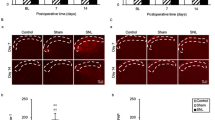Abstract
The release of peptides from the magnocellular neurones of the hypothalamus, whose axons terminate on capillaries in the neurohypophysis, has been likened to the release of neuro-transmitters from conventional synapses in other parts of the nervous system1. These oxytocin and vasopressin producing neurones generate action potentials within their perikarya, and the number and pattern of spikes propagated to the neurohypophysis govern the quantity of peptide released into the circulation2,3. We do not know, however, if the release of these peptides is modified at the level of the axon terminal as occurs in conventional synapses in the form of presynaptic inhibition or facilitation4,5. Within the hypothalamo-neurohypophysial system a mechanism of this type could operate either synaptically through the axo-axonal connections which are found on the neurosecretory cells6, or through substances reaching the neurohypophysis from adjacent tissues. The observation of enkephalin-containing fibres7 and opiate receptors23 within the neurohypophysis, and the presence of large amounts of β-endorphin in the adjacent parts of the pituitary gland8–10, make these endogenous opioids possible candidates for such a function. Studies of lactation in mice suggest that opiates block the release of oxytocin11, while a considerable body of evidence suggests that the reverse is true regarding the release of vasopressin12,13. We provide here evidence that opiates inhibit the electrically induced release of oxytocin by an action on or close to the axon terminals within the neurohypophysis, and combine this with evidence to suggest that endogenous opioids tonically suppress the release of oxytocin in response to physiological stimuli.
This is a preview of subscription content, access via your institution
Access options
Subscribe to this journal
Receive 51 print issues and online access
$199.00 per year
only $3.90 per issue
Buy this article
- Purchase on Springer Link
- Instant access to full article PDF
Prices may be subject to local taxes which are calculated during checkout
Similar content being viewed by others
References
Cross, B. A. et al. Rec. Progr. Harm. Res. 31, 243–295 (1975).
Wakerley, J. B. & Lincoln, D. W. J. Endocr. 57, 477–493 (1973).
Poulain, D. A., Wakerley, J. B. & Dyball, R. E. J. Proc. R. Soc. B196, 367–384 (1977).
Eidelberg, E. Progr. Neurobiol. 6, 81–102 (1976).
Westfall, T. C. Physiol. Rev. 57, 659–728 (1977).
Bargmann, W. Int. Rev. Cytol. 19, 183–201 (1966).
Rossier, J. et al. Nature 277, 653–655 (1979).
Lazarus, L. E., Ling, N. & Guillemin, R. Proc. natn. Acad. Sci. U.S.A. 73, 2156–2159
Li, C. H. & Chung, D. Proc. natn. Acad. Sci. U.S.A. 73, 1821–1824 (1976).
Pelletier, G. et al. Endocrinology 100, 770–776 (1977).
Haldar, J. & Sawyer, W.H. Proc. Soc. exp. Biol. Med. 157, 476–480 (1978).
Duke, H. N., Pickford, M. & Watt, J. A. Q. Jl exp. Physiol. 36, 149–158 (1951).
Bisset, G. W., Chowdrey, H. S. & Feldberg, W. Br. J. Pharmac. 62, 370–371 (1978).
Dyball, R. E. J. & Koizumi, K. J. Physiol., Lond. 201, 711–722 (1969).
Lincoln, D. W., Hill, A. & Wakerley, J. B. J. Endocr. 57, 459–476 (1973).
Clarke, G., Fall, C. H. D., Lincoln, D. W. & Merrick, L. P. Br. J. Pharmac. 63, 519–527 (1978)
Caretens, E., Tulloch, I., Zieglansberger, W. & Zimmermann, M. J. Physiol., Lond. 284, 137P (1978).
Jessell, T. M. & Iversen, L. L. Nature 268, 549–551 (1977).
Pollard, H., Llorens, C., Bonnet, J. J., Costentin, J. & Schwartz, J. C. Neurosci. Lett. 7, 295–299 (1977).
Starke, K. Rev. Physiol. Biochem. Pharmac. 77, 1–124 (1977).
Rivier, C., Vale, W., Ling, N., Brown, M. & Guillemin, R. Endocrinology 100, 38–241 (1977)
Bruni, J. F., van Vugt, D., Marshall, S. & Meites, J. Life Sci. 21, 461–466 (1977).
Simantov, R. & Snyder, S. H. Brain Res. 124, 178–184 (1977).
Author information
Authors and Affiliations
Rights and permissions
About this article
Cite this article
Clarke, G., Wood, P., Merrick, L. et al. Opiate inhibition of peptide release from the neurohumoral terminals of hypothalamic neurones. Nature 282, 746–748 (1979). https://doi.org/10.1038/282746a0
Received:
Accepted:
Issue Date:
DOI: https://doi.org/10.1038/282746a0
This article is cited by
-
µ-Opioid receptor antagonism facilitates the anxiolytic-like effect of oxytocin in mice
Translational Psychiatry (2024)
-
Oxytocin and the social facilitation of placebo effects
Molecular Psychiatry (2022)
-
Naloxone potentiates the release of oxytocin induced by systemic administration of cholecystokinin without enhancing the electrical activity of supraoptic oxytocin neurones
Experimental Brain Research (1992)
-
Pituitary astrocytes from the neural lobe of rats
Cell and Tissue Research (1990)
-
Coexisting peptides in hypothalamic neuroendocrine systems: Some functional implications
Cellular and Molecular Neurobiology (1989)
Comments
By submitting a comment you agree to abide by our Terms and Community Guidelines. If you find something abusive or that does not comply with our terms or guidelines please flag it as inappropriate.



